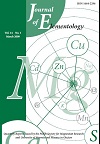Influence of water contamination on the accumulation of some metals in Hydrocharis morsus-ranae L.
Wydanie: 1/2012
Otrzymano: Brak danych
Zaakceptowano: Brak danych
Opublikowano online: Marzec 22, 2012
Autorzy:
Brak danych
Kategorie: Biology and microbiology, Pollution and environment
DOI: 10.5601/jelem.2012.17.1.03
Abstrakt:
European frogbit (Hydrocharis morsus-ranae) grows mainly in stagnant, eutrophic and mesotrophic waters. It is found in various water ecosystems, but finds the optimal conditions for development in ecosystems formed with water soldier (Stratiotes aloides). The shortage of detailed literature data on the properties of water bodies where European frogbit and water soldier grow has stimulated this study, whose aim has been to determine the values of selected water quality parameters and concentrations of some metals in tissues of both hydrophytes. The study was conducted in the late spring and summer of 2007 and 2008 and relied on environmental samples of water and plants (9 locations, including a field pond, a draining ditch on Pucka Isle, watercourses in Świdwie Nature Reserve, an oxbow lake of the Bug River and a flood pool near Głębokie Lake). The concentrations of N-NO3, N-NO2, N-NH4 and PO43– as well as the elements K, Na, Mg, Ca, Cd, Pb, Cu, Zn, Mn and Fe were measured in the water samples. Furthermore, the percentage of oxygen dissolved in water and the pH and electrolytic conductivity of water were determined. In order to assess the accumulation of metals by plants, the content of the same metals was measured in the water. It was determined that Hydrocharitetum morsus-ranae L. associations grow in physiochemically very diverse aquatic environments. The range of differences in the examined water quality indicators was broader for European frogbit than for water soldier. With respect to the concentration of Zn, N and P compounds, pH and the content of dissolved oxygen in water, the ranges were the same for both species. Hydrocharis morsus-ranae and Stratiotes aloides differed in the accumulation of the metals. The range of the accumulation of most metals (except of K and Ca) was broader for Europen frogbit than for water soldier. In respect of Na, the range of accumulation for both plant species was the same. European frogbit spreads in water bodies in which the water is considered contaminated due to the concentrations of Cd, Pb, Cu and P.
Cytacja:

Gałczyńska M., Bednarz K. 2012. Influence of water contamination on the accumulation of some metals in Hydrocharis morsus-ranae L. J. Elem. 17(1): 31-41, DOI - 10.5601/jelem.2012.17.1.03.
Słowa kluczowe:
metals, Hydrocharis morsus-ranae L., Stratiotes aloides L., water
O wydaniu:

17.1.2012
Jsite


